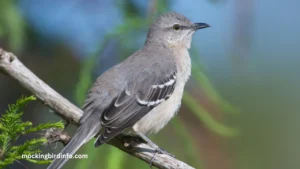Across Texas, the sound of the Northern Mockingbird singing is as iconic as the warmth of a summer breeze or the rustling of prairie grasses. Its song is more than a delightful melody; it’s a symbol of the resilience and spirit that define the Lone Star State.
The mockingbird’s unique characteristics and profound significance have made it not only a cherished bird but an emblem of Texas’ rich cultural fabric.
What sets the mockingbird apart from countless other birds? Its remarkable ability to mimic sounds, bold nature, and deep connection to Texas’ history and culture are just a few reasons it earned the title of state bird.
By choosing this small, unassuming bird, Texas signaled that even the most modest creatures could embody the state’s values of strength, independence, and adaptability.In this article, we’ll uncover why the mockingbird’s legacy continues to hold such importance.
From its historical significance and legislative journey to its lasting impact on Texan culture, we will explore why this bird remains a beloved symbol in the hearts of many.

Contents
- 1 Unique Qualities of the Mockingbird
- 2 Historical and Cultural Significance in Texas
- 3 The Process of Selection as the State Bird
- 4 The Mockingbird’s Continued Significance
- 5 Conclusion
- 6 FAQs
- 6.1 1. Why was the mockingbird chosen as the state bird of Texas?
- 6.2 2. What year did Texas name the mockingbird as its state bird?
- 6.3 3. How does the mockingbird’s song reflect its significance?
- 6.4 4. Are mockingbirds found in all parts of Texas?
- 6.5 5. Why is the mockingbird considered a symbol of resilience?
- 6.6 6. Are there any other states with the mockingbird as their state bird?
Unique Qualities of the Mockingbird
Vocal Mimicry: The mockingbird’s greatest claim to fame is its uncanny ability to mimic the calls of other birds, animals, and even mechanical sounds. This trait showcases not just an impressive memory but also a complex, adaptive intelligence.
The bird can replicate over 50 different sounds, creating a rich symphony of calls that fill the Texan air. This mimicry isn’t merely for show—it serves practical purposes, like attracting mates and warding off potential threats.
Aggressiveness: Despite its modest size, the mockingbird is renowned for its fierce defense of territory. It will chase away birds much larger than itself, such as hawks and crows, and even confront small mammals that come too close to its nest.
This bold behavior has come to symbolize courage and tenacity, characteristics that resonate deeply with the Texan identity, where resilience against challenges is a shared value.
Adaptability: Mockingbirds are highly adaptable, flourishing in a variety of environments—from urban gardens to rural plains. This ability to thrive across landscapes mirrors Texas’ diverse geography and its people’s capacity to adapt to challenges, making the bird a fitting symbol for the state’s versatility.
Whether seen hopping along the sidewalks of Dallas or flying through the fields of the Hill Country, the mockingbird’s adaptability is a testament to its survival skills.
Historical and Cultural Significance in Texas
Early Texan Life: The mockingbird’s presence was deeply felt by the early settlers and indigenous tribes who called Texas home. Its song, often heard at dawn or twilight, was a familiar sound that connected people to their environment.
For many, the bird’s singing became part of daily life, offering both comfort and a reminder of the natural world’s beauty.
Symbolism: In Texas, the mockingbird is more than a bird; it is a symbol of freedom, resilience, and identity. Its continuous song represents the enduring spirit of the state, singing day and night regardless of circumstances.
The bird’s independence and powerful voice make it a natural representation of Texas’ pioneering spirit. Unlike other birds that may flee at the first sign of danger, the mockingbird stays firm, defending its space and community—an embodiment of standing one’s ground, a trait Texans hold dear.
Folklore and Legends: The mockingbird has also found its way into Texan folklore and art. In traditional tales and songs, the bird is often portrayed as a bringer of good fortune or a vigilant protector against unseen threats.
Some stories suggest that a mockingbird’s song at night signals that it is guarding its territory from nocturnal predators, imbuing the bird with a sense of mystical guardianship. This folklore further cements the mockingbird’s status as a figure of cultural importance.

The Process of Selection as the State Bird
Legislative Process: The decision to name the mockingbird as the state bird wasn’t made overnight. In the 1920s, Texans recognized the need for a state bird that represented their values.
Advocacy groups and nature enthusiasts pushed for the designation, and the process gained traction when the Texas Federation of Women’s Clubs began lobbying for it. Their efforts included organizing educational campaigns and encouraging schools to participate in choosing a representative bird.
Competing Birds: The competition was fierce. Birds like the scissor-tailed flycatcher, known for its striking appearance, and the cactus wren, famous for its association with the arid landscapes of Texas, were also considered.
Each bird had its appeal, but none could match the mockingbird’s widespread presence and symbolic power. The bird’s song, recognizable and unique, along with its courageous behavior, ultimately won over the public and legislators.
Public Opinion: The support for the mockingbird was widespread and enthusiastic. Schoolchildren voted, local newspapers published articles highlighting the bird’s virtues, and the general public voiced its approval.
This collective support culminated in the Texas Legislature officially naming the mockingbird as the state bird on January 31, 1927. The decision reflected a shared belief that the mockingbird’s attributes resonated with the essence of what it meant to be a Texan.
The Mockingbird’s Continued Significance
Conservation Efforts: Today, protecting the mockingbird involves safeguarding the habitats that allow it to thrive. As urban development increases, conservation groups emphasize the importance of preserving natural spaces to support not only the mockingbird but countless other species.
By keeping these environments intact, Texans ensure that future generations can continue to experience the mockingbird’s song.
Educational Initiatives: The mockingbird plays an important role in environmental education throughout Texas. Schools and community programs often use the bird as a teaching tool to help children learn about ecosystems, the importance of conservation, and the beauty of Texas’ natural heritage.
This focus on education reinforces the value of preserving wildlife and encourages young Texans to become stewards of their environment.
Cultural Identity: The mockingbird’s song is a familiar and beloved sound in Texas. It has inspired everything from poems and songs to public art, reflecting the deep connection between the bird and the state’s culture. Even in urban areas, hearing a mockingbird sing from a power line or tree is a reminder of nature’s presence and the shared identity that binds Texans together.
Conclusion
The mockingbird’s story in Texas is one of admiration and symbolism. As a bird that embodies the spirit of resilience, independence, and boldness, it continues to be a vital part of Texas’ identity.
Choosing the mockingbird as the state bird was more than a legislative act; it was a recognition of shared values and a love for the natural beauty that surrounds the state. The legacy of the mockingbird is a call to action for Texans to cherish and protect their wildlife.
By celebrating the mockingbird, we not only pay homage to a bird with an impressive song and fearless nature but also reaffirm the values that make Texas unique. It’s a reminder that even the smallest voices can make a powerful impact and that the natural world around us is worth fighting for.
FAQs
1. Why was the mockingbird chosen as the state bird of Texas?
The mockingbird was chosen because of its unique characteristics like vocal mimicry, fearlessness, and its representation of the state’s values of resilience and freedom.
2. What year did Texas name the mockingbird as its state bird?
Texas designated the mockingbird as its state bird in 1927.
3. How does the mockingbird’s song reflect its significance?
The bird’s song, capable of mimicking a wide range of sounds, reflects its adaptability and symbolizes Texas’ diverse and independent nature.
4. Are mockingbirds found in all parts of Texas?
Yes, mockingbirds are widespread and can be found across Texas, from cities to rural areas.
5. Why is the mockingbird considered a symbol of resilience?
Its aggressive defense of its territory and its adaptability to various environments make the mockingbird a powerful symbol of resilience.
6. Are there any other states with the mockingbird as their state bird?
Yes, the mockingbird is also the state bird of Florida, Mississippi, Arkansas, and Tennessee.








